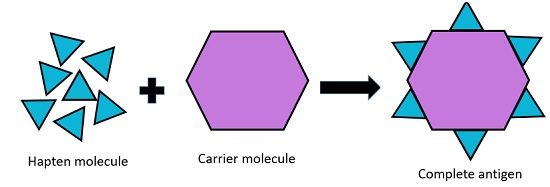The difference between antigen and antibody is mainly due to the following factors like functional role, specificity factor and foreignness.
Functional role: Antigen incites the immune system, whereas the antibody is produced in response to a specific antigen.
Specificity factor: Both antigen and antibody are specific. The specificity of antigen is due to the presence of epitopes, while the specificity of an antibody is due to the existence of paratopes.
Foreignness: An antigen is a foreign particle, which induces the antibody production. As the foreignness of the antigen increases, the formation of the antibodies will be more. In simple words, we can say that an antigen attacks the immune system and an antibody protects the immune system.
The study of antigen and antibody is highly recommended in the field of medical science, as it helps in vaccine designing and the susceptibility of a person towards any kind of infection and disease. Serological tests can be performed to identify the concentration of antigen and antibody in a diseased person.
Here, we will talk over some important terms related to the given context along with the comparison, definition, types, structure and key differences between the antigen and antibody.
Content: Antigen Vs Antibody
Comparison Chart
| Features | Antigen | Antibody |
|---|---|---|
| Denoted by | Ag | Ab |
| In relation to immune response | Antigens are called immunogens | Antibodies are called immunoglobulins |
| Composed of | Composed of protein, lipid, carbohydrate and nucleic acid. But majority of them are proteins & polysaccharides which are most ‘’antigenic’’ | Composed of conjugated proteins like Glycoprotein, lipoprotein etc |
| Origination | It generally exists in the surrounding, while a few exists inside the body | It originates within the body |
| Role | It causes diseases or allergic reactions | It protects the immune system by lysis, phagocytosis and precipitation of an antigenic substance |
| Foreignness | It is a foreign molecule for the body | It is not |
| Size | Variable (large molecules are highly antigenic) | Variable, according to the different classes of immunoglobulins |
| Specificity/ Determinants | It’s specificity is due to the presence of epitopes | It’s specificity is due to the presence of paratopes |
| Processing | It is processed by APCs ( antigen presenting cells like macrophages, dendritic cells, B-cells | It is processed by plasma B-cells |
| Structural diversity | It shows high complexity | It possesses a Y-shaped structure |
| Types | Endogenous, exogenous and autoantigens | IgG, IgM, IgA, IgD and IgE |
Definition of Antigen
Antigens are the foreign substances recognized by the particular antibodies. All the antigens cannot induce an immune response, but which are capable termed as immunogens. The antigens can be bacteria, virus, fungi, etc. and other than that, it can be dust, pollen grains etc.
Important Terms to remember
- Immunogen
- Antigenicity
- Immunogenicity
- Immunological reactivity
- Antigenic determinant
- Foreignness
- Complete antigen
- Haptens
- T-cell dependent antigen
- T- cell-independent antigen
Immunogen: It can define as any foreign substance that generates an immune response. “All immunogens can be antigens, but all antigens cannot be immunogens”.
Antigenecity: It is the property of an antigen, through which it has the ability to bind with specific antibodies or cell surface receptors.
Immunogenecity: It is the property of an antigen to generate an immune response.
Immunological reactivity: It can define as the specific reaction of antigen and antibody sensitised cells.
Antigenic determinant: It is also called an epitope. It is another property of an antigen, by which it shows specificity towards a specific antibody. It consists of a 4-5 amino acids or monosaccharide residues. The arrangement of an epitope can be sequential or linear. These are specific in nature, and specificity is due to:
- Specific chemical nature
- Specific electrical charge
Foreignness: This is the principal property of an antigen, which determines the antigenicity of a molecule, i.e. Higher is the degree of foreignness higher is its antigenicity.
Types of Antigen
There are two types of antigen, depending upon their chemical reaction.
Complete antigen: It can induce the production of an antibody alone. It can react with a specific antibody and do not need any carrier protein molecule to induce antibody formation.
Haptens: These are also called incomplete antigens, as these cannot influence the production of the antibody alone. It cannot react specifically to an antibody, without a molecular carrier. It further categorizes into two types, as shown in the diagram below:

Diagram showing the association of hapten molecule with a molecular carrier to form a complete antigen is given below:

T-cell dependent antigen: These are the protein antigens, which can activate b-cells only by the help of t-cells. It can produce all immunoglobulins; IgG, IgM, IgA, IgD and IgE. Its structure is quite complex, and this kind of antigenicity found in most of the pathogenic microorganisms like a virus.
T-cell independent antigen: Other than protein molecule, it contains a polysaccharide that can directly activate the b-cells without t-cell association. It can only produce IgM antibody. The antigens belong to this group, have simple morphology.
Definition of Antibody
Antibodies are the large, organic and Y-shaped molecules, which form in reaction to the particular antigens. Its primary function is to recognize the invaders and to destroy or neutralize them. This is the key element of adaptive immunity.
Important Terms to remember
- Immunoglobulin
- Humoral immunity
- Plasma cells
- B- lymphocytes
Immunoglobulin or Ig: It is a class of proteins, which are present in the blood plasma of the immune system, and functions as an antibody. All antibody can be immunoglobulins, but all immunoglobulins cannot be an antibody. There are five classes of immunoglobulins; IgG, IgM, IgA, IgD and IgE.
| Properties | IgG | IgA | IgM | IgD | IgE |
|---|---|---|---|---|---|
| Constitution | 80% of total Ig | 10-15% | 5-10% | 0.2% | 0.1% |
| Location | Blood, lymph, intestine | Body secretions, blood, lymph | Blood, lymph, B-cell surface | Blood, lymph, b-cell surface | Mast cells and basophils cells |
| Role | Production of complement protein, also involved in neutralization, agglutination | Provides localized protection in external secretions | Involved in production of complement protein, agglutination | Act as b- cell receptor | Involved in hypersensitive reactions |
| Half life | 23 days | 6-8 days | 5 days | 3days | 2days |
| Placenta transfer | Yes | No | No | No | No |
| Structure | Monomer | Dimer | Pentamer | Monomer | Monomer |
 |  |  |  |  |
Humoral immunity: Antibodies direct the humoral or antibody-mediated immunity. In this type, the antibodies formed by the plasma cells perform the following activities like phagocytosis, opsonisation, and neutralisation etc.
B-lymphocytes: It is also called B-cells. B-lymphocytes originate from the stem cells of the bone marrow and a part of the humoral immunity.
Plasma cells: It forms after the maturation of B-cells. Plasma cells are considered as the hub for an antibody production, which can produce about 2000 antibodies per second.
Structure of an Antigen
 It mainly comprises protrusions on the cell surface, which are called antigenic determinants (epitopes). These protrusions give specificity to an antigen molecule, after which it can only bind to the definite antigen-binding site of an antibody.
It mainly comprises protrusions on the cell surface, which are called antigenic determinants (epitopes). These protrusions give specificity to an antigen molecule, after which it can only bind to the definite antigen-binding site of an antibody.
Structure of an Antibody

It consists of 4 polypeptide chains:
- Two heavy chains(H-chain):- 440 amino acid long
- Two light chains (I- chain):- 220 amino acid long
Hence, an antibody represents as H2L2. H-chain and l-chain attach by a disulphide bond. L-chain is similar in all immunoglobulins, while H-chain differs in all immunoglobulins;
| Immunoglobulins | H-chain |
|---|---|
| IgG | Ƴ (gamma) |
| IgA | α (alpha) |
| IgM | µ (mu) |
| IgD | δ (delta) |
| IgE | Ɛ (epsilon) |
Cr: It stands for the constant region. It is the lower part of the Y-shaped antibody that is invariable in nature. For ƴ, α and δ (Cr is 330 amino acid long) and for µ & ɛ (Cr is 440 amino acid long).
Vr: It stands for the variable region. It is present on the terminal ends of both h-chain and l- chain of an antibody, which is variable in nature. In each class of immunoglobulin, variable region differs and called the hypervariable region (5-10 amino acid long).
Fab: It stands for fragment antigen binding-site, which is found in the N-terminus region of an antibody. The two-variable regions form one antigen-binding site.
Fc: It stands for fragment crystallisation, which is the remaining part of a variable region participating in a cellular attachment.
Key Differences Between Antigen and Antibody
- The antigen and antibody are denoted as Ag and Ab, and also termed as immunogen and immunoglobulin.
- Antigens exist both inside and outside the human body, whereas antibodies originate within the human body.
- The major role of an antigen is to cause diseases or allergic reactions, whereas antibodies produced in response to a particular antigen and it can cause lysis or precipitation of the antigenic substance.
- Antigens are processed by the different antigen-presenting cells inside our body, whereas antibodies are processed or differentiated from the B lymphocytes.
- The antigens possess a high complexity in their structure, while the antibodies exist as a Y-shaped structure.
Conclusion
Therefore, we can conclude that the study of the antigens and antibodies can help us to determine the potency of the foreign body and the kind of immunity developed in our body in counter to that specific antigen.